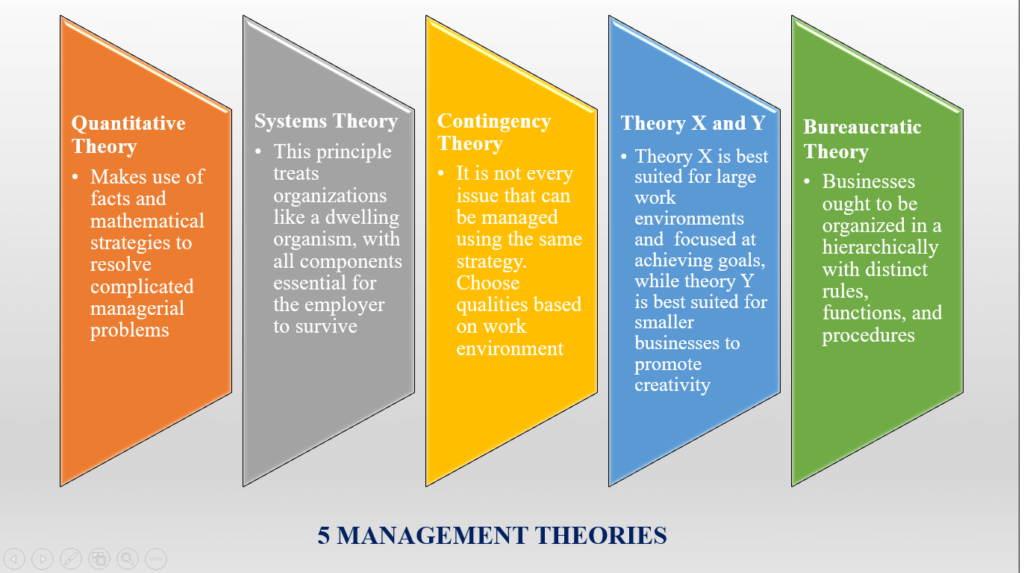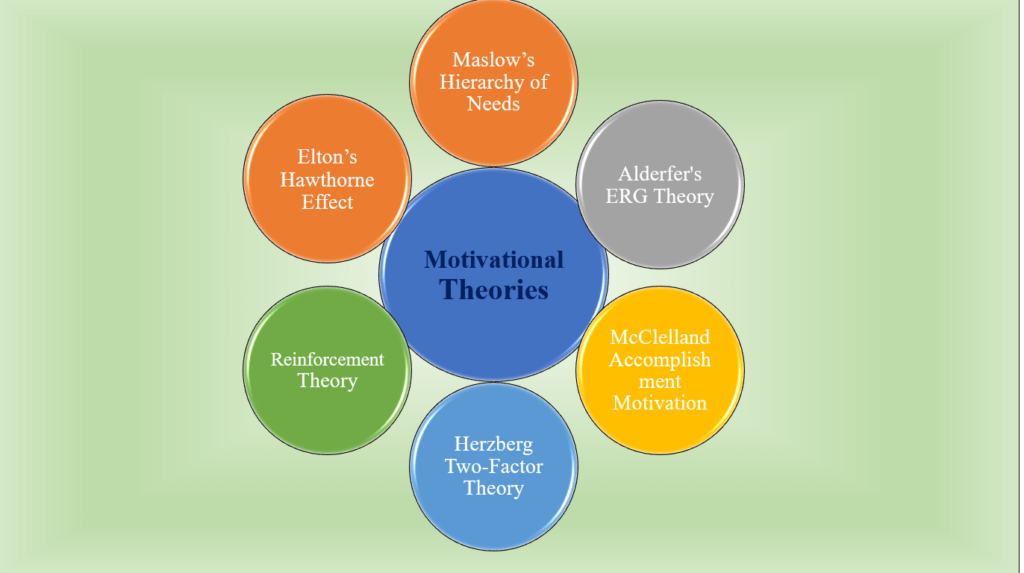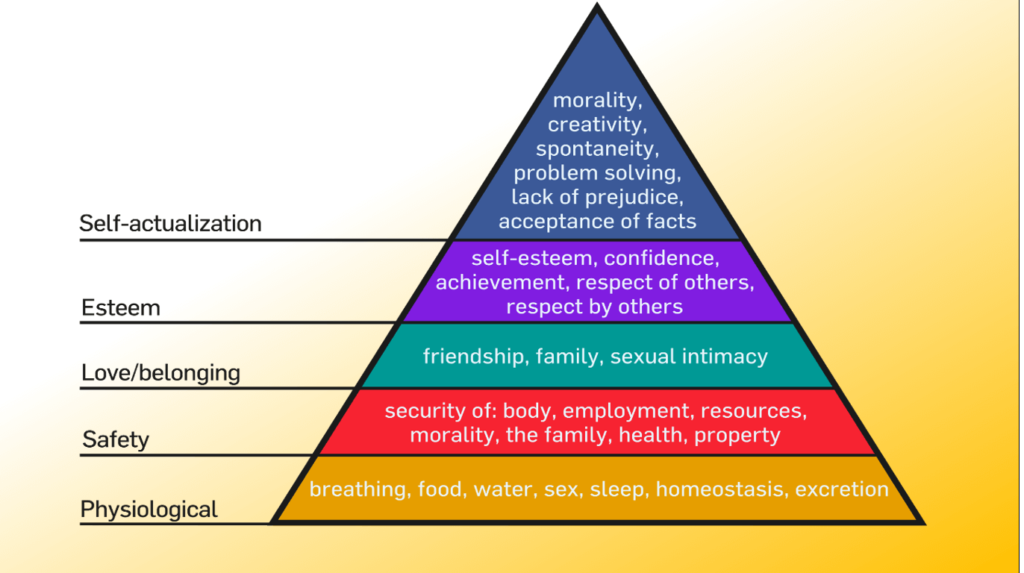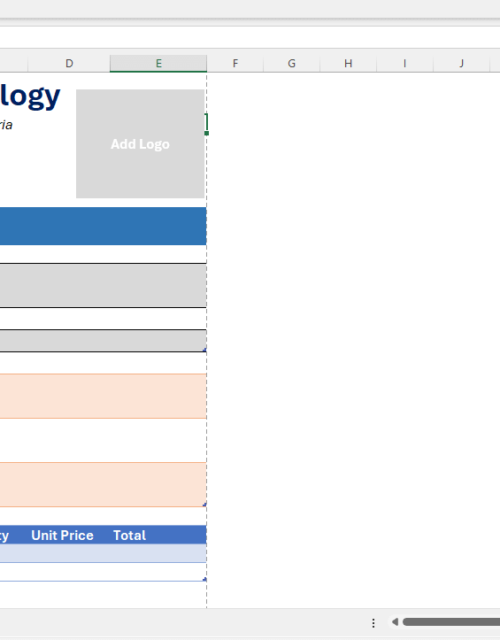Management Theories and their Organizational Impact

Management theories provide management strategies, frameworks, and guidelines that employers can implement in their offices. Organizations require different controls for different work environments.
For hundreds of years, theorists have searched for the best form of management for various businesses. The framework given in these management theories can be used to create a framework for management in today’s organizations.
In this article, you’ll learn basic management theories and how they impact organizations.
What is a Theory?
A theory is a logical abstraction regarding a phenomenon or the conclusions of such an abstraction. Contemplative and logical thought are frequently linked to procedures like observational study or research.
A theory is a rational explanation of some aspect of nature, such as a law, hypothesis, or fact. Theory refers to the process of explaining and predicting phenomena or facts. Theory attempts to answer why and how questions in explanatory research. A statement that is not intended to explain or predict anything is not a theory. More importantly, the theory must be testable, at least eventually.
Theories can come from a scientific field, a non-scientific one, or none at all. A theory’s claims may, for instance, provide broad explanations of how nature functions depending on the situation. Although the word has Greek roots, it now has a number of connotations that are similar.
What do you understand by management theories?
Management theories are ideas that accompany suggested management tactics, which may include implementable tools like frameworks and guidelines in contemporary businesses. Professionals typically introduce a number of elements from many management theories that best fit their workforce and corporate culture rather than relying entirely on one management philosophy.
They are sets of guidelines used to manage an organization, corporation, or other group. They may help shape the organizational goals and manager-implemented employee motivation initiatives. Real-world leaders employ ideas from various theories simultaneously, despite the fact that the ways in which you can apply them can vary depending on the theory.
Put simply, management theory is the idea of how people guide their employees within an organization. To run a business, you need to understand what motivates and guides people in your business. Management theory explains what motivates employees and how leaders can use these motivations to control and guide their employees.
Advantages of Modern Management Theory
The advantages of incorporating modern management theory are:
- Increased productivity: Modern management theory uses mathematical and statistical techniques to evaluate performance within an organization. Managers can use this data to understand employee behavior and design solutions that maximize employee potential. For example, you can implement processes that make your employees’ tasks more efficient, or provide training programs to improve their skills. Help you make decisions:
- Increased employee engagement: As mentioned earlier, modern management theory studies the motivations of employees to work beyond financial gain. Managers applying this theory can identify and implement processes and procedures that address the diverse needs of their employees. When employees are happy with their jobs, their morale and engagement improve, making them want to stay with the company.
- Promote objectivity: Modern management theory emphasizes the use of mathematical methods. These techniques allow managers to make decisions based on data and evidence rather than personal opinions and feelings. You can also test different options to evaluate which one best supports your organization. This allows administrators to implement more effective solutions. Allows customization:
- Help you make decisions: Modern management theory often provides insight into the factors that managers need to investigate that they can use to evaluate their organizations and departments. Knowing what to look for can help administrators identify problems and find possible solutions. Using mathematical techniques, data can also be used to support these solutions and final decisions.
- Allows adaptability: Modern management theory recognizes that today’s organizations often exist in rapidly changing environments. This theory emphasizes the importance of recognizing the impact of internal and external factors on a business and encourages managers to use various techniques and approaches to address them. For example, when developing solutions, managers can use new technologies to streamline processes or perform statistical modeling.
Mention 5 management theories you know and explain them
Managers can use a variety of contemporary management strategies within a business. Managers have the option of combining these strategies as a guide for leading their teams and advancing company goals. The following are the three methods of modern management:

Quantitative theory of management
The quantitative approach to management makes use of facts and mathematical strategies to resolve complicated problems. Depending at the commercial enterprise area, managers can also additionally use strategies like laptop simulations or records fashions to evaluate overall performance. This evaluation allows them to recognize what’s running and what isn’t always in the commercial enterprise, then expand answers to resolve or enhance the problems they find. Managers also can use those strategies and information to decide the blessings or dangers of various ideas. This technique can assist managers make goal choices primarily based totally on information and facts, instead of private evaluations or feelings, that guide the commercial enterprise.
This modern-day management technique includes 3 branches:
- Management science: Management science makes a specialty of the usage of mathematical and statistical techniques to shape powerful commercial enterprise answers and attain dreams. Examples of those gear consist of the Program Evaluation Review Technique (PERT), the crucial route approach (CPM) and sampling. Managers can use those gear in numerous situations, together with task control, budgeting and growing schedules.
- Operations management: In operations management, managers put into effect practices that assist make commercial enterprise and manufacturing techniques greater green. Depending at the situation, this approach can also additionally require managers to restructure or redecorate their techniques. Some of the gear they use consist of forecasting, first-rate manipulate techniques and task planning. Often, those managers goal to make greater or higher merchandise via the greater green techniques they put into effect.
- Management Information System (MIS): A MIS represents a database that organizes an agency’s information, and bosses use this gadget to guide knowledgeable decision-making. This gadget collects and shops real-time information, permitting managers to run reviews on regions like financials, timelines, employees and inventory. Managers can then screen this records and use it to evaluate overall performance and make upgrades or expand answers as needed.
Systems management theory
This principle treats organizations like a dwelling organism, with all components essential for the employer to survive. It was developed by Ludwig von Bertalanffy,.It states that everyone components of an employer, from the CEO to the entry-degree employee, need to paintings in concord for the employer to survive. Companies that make use of this principle suppose that departments and personnel need to paintings as a collective institution and now no longer an remoted unit. Synergy and interconnectedness among departments are key with this principle.
While striving for concord among departments is essential in a employer, maximum organizations do not want to depend on synergy a lot for his or her every day functions. For example, the accounting branch of a small employer does not want to be absolutely in sync with the HR branch. This control principle is greater of a manner you may view the employer, now no longer an genuine control style.
The management technique in addition defines an agency via way of means of dividing it into unique additives. These additives show how unique components of the agency paintings collectively towards a not unusual place goal:
- Inputs: Inputs constitute the elements which are had to create items and offerings. For example, inputs can also additionally consist of uncooked materials, capital, era or records.
- Transformational process: Transformational techniques constitute the sports or competencies that convert the agency’s inputs into outputs. For example, those techniques can also additionally consist of personnel’ paintings obligations or operational sports.
- Outputs: Outputs constitute the effects produced via way of means of an agency. These outputs can also additionally consist of merchandise, offerings and economic effects, consisting of profits.
- Feedback: Feedback represents records associated with the agency’s results or outputs. Leaders can use these records to persuade or make choices associated with the agency’s inputs.
In the systems technique, control group of workers contributors expand dreams and techniques that guide their agency’s normal targets and overall performance.
Theory of contingency management
The theory of contingency management was created by Fred Fiedler. According to this notion, not every issue can be managed using the same strategy. According to Fiedler, managers’ character qualities affected how they lead their teams. This theory places a great focus on the necessity for leaders to be adaptable and pick their finest qualities based on their present work environment.
Other management theories or approaches include:
Theory X and Y
Theories X and Y were created by Douglas McGregor. He claimed that managers’ perceptions of the motivations of their team members influenced managerial approaches. Managers that believe their workforce is apathetic apply theory X, authoritarianism. Managers that believe their workforce is dedicated, self-driven, and responsible embrace theory Y, participative management. According to this theory, theory X is best suited for large work environments to ensure that employees are focused on achieving organizational goals, while theory Y is best suited for smaller businesses because it allows for easier employee participation in decision-making and promotes the use of creativity.
The traditional management theory
According to the Classical Management Theory way of thinking, only physical and financial needs may inspire employees. It demands a transparent management system with owners, middle management, and supervisors as the three levels of staff.
According to this viewpoint, the workplace is like an assembly line, with each employee performing a specific task rather than multitasking. People who subscribe to this view think that incentives such as financial rewards for competent work are what motivate employees. Businesses will frequently notice an increase in productivity when they use this principle in practice. It can aid in organization and force workers to concentrate on the bottom line.
Theory of Bureaucratic Management
According to Max Weber’s Bureaucratic Management Theory, which was developed in the late 1800s, businesses ought to be organized in a hierarchical organization with distinct rules, functions, and procedures.
According to this view, bureaucracy manifests itself in six key ways: a hierarchical organizational structure, task specialization, formal selection, rules, advancement based on performance, and an impersonal workplace. According to this theory, promotions are only based on performance rather than personal character or connections.
Due to its inflexible structure, this management philosophy has lost some of its appeal during the last century. Although it makes sense in theory for an office to have standards and norms that everyone must abide by, in reality there will always be feelings and interpersonal interactions in an office that will go against these formal regulations.
What is Motivation?
The process that starts, directs, and sustains goal-oriented behaviors is referred to as motivation. Whether you’re drinking a drink of water to quench your thirst or reading a book to learn something new, motivation is what pushes you to take action.
Motivation is the cause of a behavior’s initiation, continuation, or termination in humans and other animals at a certain time. Motivational states are frequently interpreted as internal forces that produce a disposition to participate in goal-directed activity in the agent.
A person must be internally motivated. Whether we refer to it as a need or a drive, motivation is a state of being inside of us that yearns for a change, either in the environment or in the self. When we draw from this source of power, motivation gives us the drive and direction we need to interact with the world in a way that is adaptable, open-ended, and problem-solving (Reeve, 2015)[1].
Goal-directed activity that is enthusiastic and persistent is the essence of motivation. We move and act when we are motivated.
The satisfying of requirements that are necessary for maintaining life or crucial for well-being and growth affects motivation. The organism’s physiological needs for food, drink, and sex (yes, sex) function to both sustain life and give satisfaction.
What are the motivational theory models you know?
Since the dawn of time, theorists have studied human behavior, seeking explanations for diverse elements of social processes that are backed by empirical data. Using a particular concept or idea, numerous theorists have proposed potential explanations for why people behave in a certain way. These ideas work together to provide us a better understanding of how human behavior functions.
Psychology frequently discusses motivations in terms of drives—internal states that become active when the physiological functions of the body are out of balance—and goals—desired end states that we work toward. Thus, motivation can be thought of as a set of behavioral responses that prompt us to work against our desires and achieve our goals by contrasting our current situation with an ideal end state (Lawrence, Carver, & Scheier, 2002).[2]
Below are the list of eleven motivational theories you should know.

Maslow’s hierarchy of needs theory
Abraham Maslow, who described motivation through the fulfilment of needs ordered in a hierarchical sequence, is the author of the most well-known content theory of motivation. Dissatisfaction drives us in the pursuit of fulfillment since met needs do not motivate.
Theory of Alderfer’s ERG
Maslow’s work is expanded upon by Alderfer’s theory of motivation, which further develops the idea of need categories. When our lower wants are met, he notes, they take up less of our attention, whereas the higher needs, the more we pursue them, tend to become more significant.
The accomplishment motivation theory of McClelland
McClelland employed a distinct conceptualization of wants, arguing that they are formed and learnt, and he shifted the focus of his studies away from satisfaction. He was sure that we can only have one dominant motive driving our conduct at once. McClelland divided the needs or motives into the categories of achievement, affiliation, and power and believed that they were influenced by both intrinsic and extrinsic forces.
Motivation-hygiene theory of Herzberg (Herzberg two-factor theory)
Originally developed to address employee motivation, Herzberg’s two-factor theory, commonly referred to as the motivation-hygiene hypothesis, identified two causes of job pleasure. He stated that motivating variables like achievement, recognition, the work itself, responsibility, and progress have an impact on job satisfaction since they are founded on a person’s need for personal development.
Alternatively, hygiene factors—representing deficiency needs—defined the work environment and had the potential to make people dissatisfied with their employment. These factors included administration and policy at the place of business, supervision, pay, interpersonal relationships, and working conditions.
Theory of reinforcement
The reinforcement theory, which emphasized the effects of human behavior as a motivating element, is the most popular process theory of motivation.
Positive reinforcements are defined as factors that improve the likelihood that the desired behavior will be repeated and are based on Skinner’s operant conditioning theory. These factors include praise, gratitude, a good grade, a trophy, money, a promotion, or any other incentive (Gordon, 1987).[3]
Adams’s theory of motivational equity
For instance, the equity theory of motivation developed by Adams in 1965 and based on the Social Exchange theory contends that we are driven when treated fairly and rewarded for our efforts.
The expectation theory of Vroom
On the other side, Victor Vroom’s expectancy theory (1964)[4] integrates needs, equity, and reinforcement theories to describe how humans select from various voluntary behaviors based on the conviction that choices will result in desired results.
Locke’s theory of goal-setting
Objectives are important drivers of action according to Locke and Latham’s (1990)[5] goal-setting theory, an integrative model of motivation. The goal-setting theory emphasizes goal clarity, difficulty, and acceptance and offers instructions for how to incorporate them into incentive programs and management by objectives (MBO) strategies in many sectors. It may be the theory that has seen the most widespread application.
Theory X and Y
Two hypotheses, Theory X and Theory Y, were put out by Douglas McGregor to explain employee motivation and its managerial implications. He categorizes workers into two groups: Theory X workers who shirk responsibility and hard work, and Theory Y workers who put out effort while in charge.
Theory Z
Dr. William Ouchi created a third theory, known as Theory Z, in reaction to this one. According to Ouchi’s thesis, a corporation can increase employee loyalty by giving them a job for life and putting an emphasis on their welfare. To inspire employees at work, it promotes teamwork and interpersonal contact.
The Hawthorne effect
The Hawthorne Effect, which Elton Mayo proposed as an explanation, contends that workers are more productive when they are aware that their work is being evaluated and measured.
Explain the Maslow’s hierarchy of needs theory
One of the most well-known psychologists of the 20th century is Abraham Maslow. Students studying business and media have overwhelmingly praised and endorsed his motivational thesis, “Hierarchy of Needs.” Let’s take a look at some of his motivational beliefs that are still popular among mass communication students. In what ways is Maslow’s theory still relevant now, 70 years later? He organized the hierarchy of requirements into five fundamental categories, including:
- Physiological needs
- Safety needs
- Social needs
- Esteem needs
- Self-actualization

Maslow researched the factors that enabled notable figures like Mahatma Gandhi, Martin Luther King Jr., Helen Keller, and Albert Einstein to live such fulfilling lives. According to Maslow (1970), self-actualized individuals are creative, impulsive, and caring toward both themselves and others. They are often private and prefer to have a small number of close friendships as opposed to many shallow ones. He believed that because these people are exceedingly self-assured and so unafraid to share beliefs that are unpopular, they do not need to conform to those of others. Peak experiences, or transcendent moments of peace accompanied by a deep sense of connection with others, are also more likely to occur in self-actualized persons.
What are the motivational packages you have for your staff under you to make them willing to put in more efforts?
Organizations use a variety of incentive packages to entice personnel to put in more efforts at work. Some of the most used packages include salary raise, award and recognition, training and development, effective communication, and bonuses. Employees believed bonuses to be more significant and advantageous to them, and they believed they had the most influence.
In my work place, the following incentives are popularly used by me and other superiors.

Bonuses and salary raise:
This is when the salary of an employee is raised because he/she accomplished a given task. Such bonuses are not regular, but come with increasing demand to accomplish a task.
Awards:
At the end of every quarter, awards are given to the best performing staff in the different departments. Though the awards are in medal form and does not come with monetary value, the respect and recognition attached to it motivates the staff.
Commendation:
We use these types of motivation daily and on regular basis to strengthen the superior-subordinate relationship. Commendation is a means of praising someone who did something right. Though nothing is attached to it, it gives employees a sense of accomplishment and a feeling of belonging to the team.
Promotion:
Depending on how many people are in our team and the project we are working on, promotion is used to encourage staff. Promotion in this respect means making a member of the team superior to others. And the criteria is by accomplishment of duty, innovation and creativity, and timely delivery of results.
These are the motivational packages used in my organization to trigger higher performance from my team.
Conclusion
The article discussed motivational and management theories, and their impact on organizations. For questions and possible suggestions, kindly use the comment box below.
[1] Reeve, J. (2015). Understanding motivation and emotion (6th ed.). Hoboken, NJ: Wiley.
[2] Lawrence, J. W., Carver, C. S., & Scheier, M. F. (2002). Velocity toward goal attainment in immediate experience as a determinant of affect. Journal of Applied Social Psychology, 32(4), 788–802.
[3] Gordon, R. M. (1987). The structure of emotions. Cambridge, UK: Cambridge University Press.
[4] Vroom, V. H. (1964). Work and motivation. New York, NY: Wiley.
[5] Locke, E. A., & Latham, G. P. (2002). Building a practically useful theory of goal setting and task motivation: A 35-year odyssey. American Psychologist, 57(9), 705-717.








